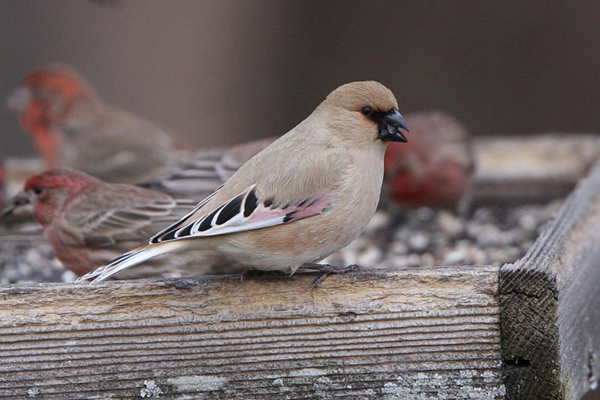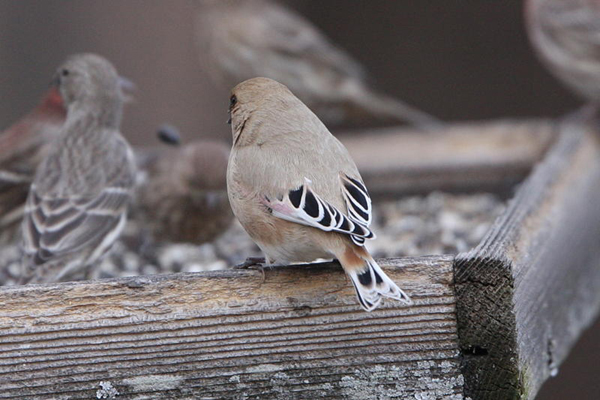I have seen Desert Finches exactly once. They were in Kazakhstan, where they belong. Desert Finches have never been reported anywhere in the western hemisphere and have definitely not shown up in the southern United States. So when a comment appeared on my post about Desert Finches in which the commenter claimed that there was a Desert Finch coming to her feeder in Jonesboro, Arkansas, well, I did the only thing a birder can do. I let her know that she was crazy.
You almost certainly do not have a Desert Finch in your backyard in Arkansas. Much more likely (though still pretty unlikely) would be one of the three North American rosy-finches (Black, Gray-crowned, and Brown-capped). I would say to go ahead and try to get even a lousy photo and we here at 10,000 Birds can try to help you ID it.
A couple of days later, when I received an email from the commenter that had two pictures attached, well, one might say I was surprised. Shocked would be another good word.
Both images of the Desert Finch in Arkansas are copyright Ron Howard and used with permission.
Other excellent images by him can be seen here.
There were three possible explanations for the images of a Desert Finch sharing a feeder with House Finches. They are:
- Someone who is VERY good at photoshop and really bored was playing games with my head. Suspects included anyone who had been taken in by my harmless April Fool’s Day prank (but this idea was quickly eliminated…the folks involved were just too friendly and the bird too outlandish to be an effective prank).
- Somehow someone had managed to capture a Desert Finch and transport it to Arkansas where it escaped and discovered the wonder of free buffet service.
- A wild Desert Finch had managed to fly from Asia to the United States and this was a first North American record, in which case this was a VERY BIG DEAL!
Before deciding which of the three possibilities was most likely I enlisted the aid of some fellow bird bloggers while asking for more information from the bird’s host. Randomly, Nate, Patrick, and Will were signed into Facebook at the time so they are who I asked for advice as to how I should proceed (if this was a first North American record, well, people needed to know, but who?). It was Nate who managed to figure out that explanation two was the most likely when he found a place in nearby London, Arkansas that sells Desert Finches at 120 USD a pair! Now, I am not saying that the bird at the feeders necessarily escaped from the bird-selling place (I’ve left a message for them and not heard back) but it seems more likely that it escaped from there or a similar location than it flying from Asia under its own power. Though, well, anything is possible, and the bird does not exhibit any feather wear that would be expected from an escaped cage-bird.
What I found even more amazing is how the bird was found and identified, information which the finder of the bird was willing to share:
I first saw the bird (which I nicknamed Kahzy after your pictures and location) on the afternoon of December 30. I have a feeder tray raised about 5.5 feet in the air and noticed an unfamiliar bird. I grabbed the binoculars and kept looking at him. He was in with a group of finches, and stayed in the tray probably a minute or even two. He then flew as something startled all the birds.
I started looking in my North American field guide for this bird and could not find him. I went through it 3 times, looking at male, female, immature, etc. Obviously, I still couldn’t find the bird’s picture. I sat down and made a written list of his characteristics and then called my 88-year old aunt who introduced me to birding. I gave her the list and she started searching all her North American books, too.
Kahzy came back again that same afternoon an hour or so later. I verified my list against what I was viewing. Auntie called back and said she couldn’t find the bird. So, I turned to the internet and thought about what kind of bird he might be. I decided with that bill and knowing he was a seed eater, I googled “black billed finch.” After 12 or 13 pages of pictures, I came across your pictures. I left a note on your blog letting you know that I’d seen one, too.
So, I called and left a message with Ron (whom I’d never met; just knew about him from a neighbor). He’d just got in from another birding adventure and called me back the next day. He asked if he could come over and sit on my deck during the morning and afternoon on January 1. We said, “Sure,” knowing that he would have the camera to take the necessary pictures to prove our story credible.
I don’t know if he really believed my story before he saw the bird or not. I had pulled up your pictures and let him look at them before he started waiting, camera in hand. Ron didn’t see the bird that morning, but he did get some shots of him later that afternoon. I knew by the excitement of a much more experienced birder that I wasn’t crazy and just imagining things. At this point, my husband, Kirby, was the only one not to have seen our Desert Finch. He just missed seeing him as Kahzy only stayed long enough for Ron to get a dozen or so photos before he flew away. Ron also came back on January 2 and took the photos you’ve seen. It’s almost as if he was posing for Ron.
Kahzy has come by to eat on the seed tray every day. (Today is Day 5.) We must be on his afternoon route. Today was the first day I had seen him eat on another feeder. He actually chased another finch out of a Vista Dome feeder. I had not seen this behavior in the 4 previous days. Afterwards, he also ate on the ground below this feeder. He finished off the afternoon back at the seed tray before leaving for the day.
New birds are fun to see, research, and mark in my field guide. However, the Desert Finch has really excited us, and his coloring continues to amaze us.
Anyway, this story serves as a precautionary tale: sometimes the most absurd birds DO show up in the most unexpected places and one shouldn’t dismiss outlandish sighting reports out of hand. Wherever Kahzy came from he is a gorgeous bird that anyone would love to have visit their feeder! Make sure that you have binoculars, a pen, paper, and a decent camera at hand near your feeder station because something crazy could show up at your house next.
If anyone has any information about escaped Desert Finches or the likelihood of very-long-range vagrancy in the species please leave a comment below.















bwah, that is incredible. and with some great photos. Don’t think I got to see it that well in Kazakhstan.
Yeah, you’re right, there’s no apparent feather wear. That may be because it was transported in a large enough cage or that it had completely finished its molt before transport, I don’t know, I’m pretty ignorant on those things. I look forward to someone more knowledgeable weighing in.
I just like that the photographer’s name is Ron Howard.
Amazing story, and well done to the finder for having the confidence to persist in her unlikely ID (despite Corey’s psychiatric diagnosis). Maybe we should make it 10,000 Birds policy now to believe every bizarre report we get sent just in case we’re pooh-poohing something of national importance!
Re the pristine plumage: do we know if the local ‘person’ who sells these beautiful Asian birds has managed to breed them so may have an established flock in a large aviary from which this bird escaped? Another explanation could be that an escapee has been living unnoticed in the wild for some time and gone through the natural moult cycles while doing so?
I had to laugh at Corey’s initial response to the report. Talk about stepping on the poor woman’s birding buzz! That made for a good chuckle. (Otherwise, I have nothing of substance to add to the question of how the bird got there. I’d suspect escapee but I’d also refrain from discounting any possibility. In my experience, birds don’t read maps and they don’t read record books.)
I should have included this in my previous comment: I live in Texas and right now we have a northern jacana, a bare-throated tiger heron and a northern wheatear who have all been in the state long enough to be seen by hundreds of birders and to make both local and AP news stories (not to mention upping the ante on Texas being THE go-to birding state!). I add that info to give a little perspective on why I said birds don’t read maps or record books.
And I’m still laughing about Corey’s response!
This species has been popping up on the avicultural market within the last year (although maybe not for the first time), so I guessed immediately that this one is an aviary escapee.
I doubt that the business offering them does any “raising” of Desert Finches, rather they are probably just acquiring them from an importer or an intermediate broker.
although the escapee is the most likely situation, it is possible the our little friend hopped a ride inside of a military cargo plane given the many flights of transport planes to that part of the world
@Sara: I did not know that.
@jesse boone: That’s a possibility that makes sense that I did not consider…interesting.
Sara wrote: “I doubt that the business offering them does any ‘raising’ of Desert Finches, rather they are probably just acquiring them from an importer or an intermediate broker.”
So it would seem. On the aviary’s site, Desert Finches are marked as a species “which can only be shipped via Delta Airlines (LAX AIRPORT) from CA location.” Their “About Us” page lists the species that they currently breed, and Desert Finch isn’t on the list. That’s not to say that they haven’t kept some, but it reduces the chances of Kahzy being a captive-bred individual.
Poor little bird – so far from home!
Considering the novelty or at least the recent resurgence in aviculture, I would bet that this guy is here in continental U.S. as a 0-order generation immigrant. There are accounts of captive breeding1, but not so many, and they are rather dated.
Well, he seems to have settled in with a good crowd.
The cargo plane transport theory is interesting, nevertheless. Does it happen (with birds, I mean)? Typically, I read of birds bringing down cargo planes from the outside rather.